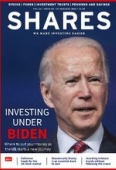Archived article
Please note that tax, investment, pension and ISA rules can change and the information and any views contained in this article may now be inaccurate.
More secrets of the income statement revealed

This week we continue the analysis of an income statement using retailer Next (NXT) to illustrate the key items.
Last week we looked at items like revenue alongside gross and operating profit. Below the operating line we find the financial income and expense line and taxes.
Next had £1.1 billion of net debt in January 2020 excluding a further £1.2 billion of lease liabilities.
The accounting rules on leases changed a few years ago to include them in the debt calculation for companies. It’s not clear what the benefits are because investors have always treated long term leases as debt. Next explains its treatment of leases on page 149 of the annual report.
The finance charge of £105.6 million is broken down in note five to the accounts.
It is comprised of interest on the bonds (debt owned by investors) of £43.6 million and finance costs on lease liabilities of £62 million.
Income from the roughly £50 million of cash held was negligible. It is always worth checking the consistency of net debt from year to year and the trend as well as any covenants attached them.
Covenants are legal clauses which act to protect the lender and which the borrower must operate within in order to keep its borrowing facilities.
Next’s £44 million of annual interest cost works out at roughly 3.8% of the value of bonds issued, which looks reasonable against the coupons attached to the bonds which can be found in the notes to the accounts on page 166.
TAXES
Taxes of £138.3 million represent an effective tax rate of 18.5%, slightly below the 19% statutory corporate tax rate and in line with the prior year.
Because interest payments reduce profit, they effectively lower the taxes that a business pays. Had Next been debt free the taxes paid would have been £158 million, (pre-tax profit of £853.9 million times 18.5%) lowering profit available for shareholders.
NET PROFIT ATTRIBUTABLE TO EQUITY SHAREHOLDERS
Again, looking at the trends rather than the one-year numbers, profit after tax has grown at 5.3% a year which looks dull, but respectable given the huge headwinds faced by clothing retailers over the last decade.
It is often easier to use a service like Sharepad or Stockopedia when looking at longer term trends because these services collate all the data in an easily readable format.
At this point it is worth taking a glance at the cash flow statement to see if profit has been supported by cash generated in the business.
Next has consistently generated cash in line with profit over the years with free cash flow representing 77% of profit. This is in large part due to capital expenditure remaining below depreciation over the last decade.
Over the last decade Next has charged £1.5 billion of depreciation while making capital expenditures of only £1.2 billion.
Free cash flow is usually defined as cash generated from operations minus capital expenditure. Free cash flow is the money available to shareholders.
It is up to management to choose how best to use that cash for the benefit of long-term shareholders. As we shall discus this is one of the most important but often overlooked decisions that contributes to the creation of shareholder value.
THE IMPORTANCE OF CAPITAL ALLOCATION
There are essentially three choices: paying dividends, reinvesting back into the business to grow future profits or buying back shares. These are not mutually exclusive, and the most profitable companies can do all three at the same time.
A small but important point on buying back shares is that it only creates value if the shares are purchased below their theoretical fair value. This is always a non-precise, subjective process, so requires some judgement.
Next’s management has frequently decided the best use of its free cash flows was to buy back shares which has resulted in the number of shares in issue shrinking by a third over the last decade to 130 million shares.
Next spent £300 million in 2020 and has forked out an average of £223 million pounds a year buying back its shares in the last decade.
This turned out to be a very good capital allocation decision for shareholders.
That’s because the ‘modest’ 5.3% growth in profit has almost doubled when divided into fewer shares which means that earnings per share has grown at an impressive compound annual growth rate (CAGR) of 9.7% a year.
CALCULATING SHAREHOLDER VALUE
The company has also paid out rising dividends over the years, rising from 66p per share to 174p, translating into a CAGR of 10% a year.
Had investors reinvested the dividends every year into more Next shares, they would’ve received a total CAGR return of 17.3% based on the end of year share prices, provided by Next in the 10-year summary of financial data.
That means an investment of £9,970 a decade ago would have turned into £49,286 today.
Reinvesting income that you don’t need means you get the full compounding kicker to total returns over longer periods.
The numbers mean nothing without context
When reading the annual report, it is important to put the performance into some context and relate them to the company’s strategy and key performance indicators.
Most companies will make strategy presentations available on their websites as well as the financial indicators management use to track performance against goals.
It is also worth looking out for capital market day presentations which are sometimes recorded where you can see and hear the senior management team talk about the business.
These sources are invaluable for interpreting company announcements and financial reports in order to assess if the company is going in its intended direction.
Think of it as the glue that binds together the bigger picture with all the financial minutiae that companies provide. In most cases, good leadership and clear communication of strategy are a sign of a well-run company that cares about its shareholders.
A well run business which also has a strong market position and good growth prospects should, over time, produce respectable returns.
Important information:
These articles are provided by Shares magazine which is published by AJ Bell Media, a part of AJ Bell. Shares is not written by AJ Bell.
Shares is provided for your general information and use and is not a personal recommendation to invest. It is not intended to be relied upon by you in making or not making any investment decisions. The investments referred to in these articles will not be suitable for all investors. If in doubt please seek appropriate independent financial advice.
Investors acting on the information in these articles do so at their own risk and AJ Bell Media and its staff do not accept liability for losses suffered by investors as a result of their investment decisions.
Issue contents
Feature
First-time Investor
Great Ideas
- Experian reports reassuring growth
- Semiconductor cycle is turning to Micron’s advantage
- Polar Capital shares remain cheap despite high quality status
- Genus shares hit new record high after upgrading guidance again
- Knockout performance from Baillie Gifford US Growth
- Buy into Disney’s long-term dominance of the entertainment sector
Money Matters
News
- Major breakthrough for Netflix as it aims to be self-sustaining
- Three small cap new issues are currently flying high
- Investors buying IAG shares will have to pay new Spanish tax
- Shares in McDonald’s stall as challenges mount
- Shares in cruise operators start to rise as potential early vaccine beneficiaries
- High hopes for Bahamas Petroleum exploration well

 magazine
magazine








